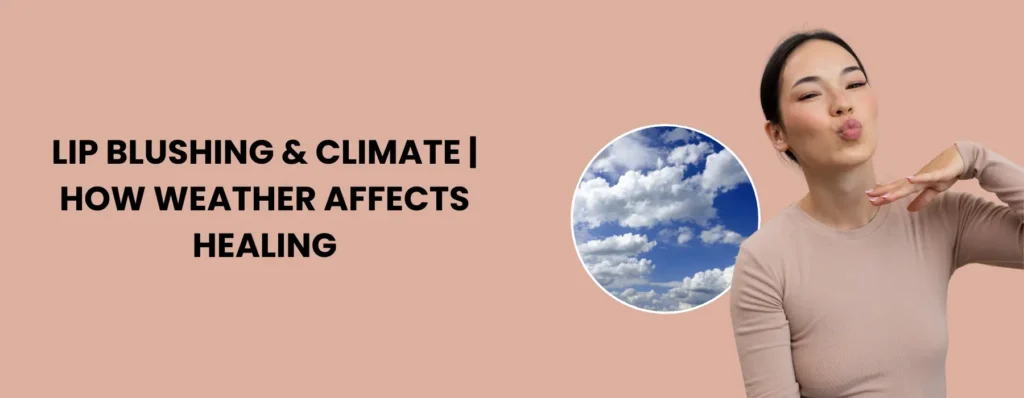Lip blushing has become one of the most popular cosmetic tattoo procedures for enhancing natural lip color and giving a youthful, defined appearance. While the process itself is quite safe and effective, one of the biggest factors influencing results is climate and weather conditions.
Whether you live in a hot, humid environment or a dry, cold region, the climate around you can significantly affect how your lips heal after the procedure.
In this article, we will explore the connection between lip blushing & climate, how different weather conditions impact healing, and what you can do to ensure your results stay flawless no matter where you are.
Lip blushing/Lips Micropigmentation is a semi-permanent tattooing technique that deposits pigment into the lips using a fine needle. The goal is to create soft, natural-looking color that enhances the natural lip tone while improving definition.
The healing process usually takes about 4–6 weeks, though the initial stage involves peeling, dryness, and pigment fading. During this phase, external factors like weather, temperature, and humidity play a major role. While proper aftercare is always important, being aware of how climate affects your healing journey can help you protect your lips and maximize your results.

The skin on our lips is thinner and more sensitive compared to other areas, which makes it more vulnerable to environmental changes. After lip blushing, your lips need extra protection because:
That’s why understanding how lip blushing & climate work together is essential for anyone undergoing this treatment, whether you live in a tropical region, a dry desert climate, or colder weather zones.
If you live in a hot, tropical region or spend a lot of time traveling to beach destinations, humidity can slow down healing. Sweating can introduce bacteria, increasing the risk of infection, while high temperatures may cause excess swelling. Additionally, direct sun exposure in hot climates can lead to pigment fading more quickly.
So, Always apply a healing ointment recommended by your doctor, avoid direct sunlight, and wear a wide-brimmed hat when outdoors.
Cold weather combined with dry air can cause lips to crack and peel excessively during the healing process. Since lip blushing already makes lips more prone to flaking, winter climates can make recovery more uncomfortable. Cracking can even disturb the pigment and lead to uneven color retention.
Always use a non-petroleum healing balm frequently, avoid licking your lips, and keep hydrated to maintain moisture balance.
Arid climates with little humidity make lips more susceptible to dryness. This can delay healing and result in more noticeable pigment fading. Dust and wind in desert regions can also irritate newly blushed lips.
Keep lips protected with a medical-grade healing cream and stay indoors during high-wind conditions to avoid irritation.
Those living in moderate climates often experience smoother healing with minimal complications. However, even in mild conditions, lips still need protection from occasional sun, wind, or seasonal changes.
Don’t neglect aftercare just because your climate feels comfortable; continue using healing ointments and sun protection
Not only does your overall climate matter, but the season of the year can also affect recovery.
By being mindful of seasonal shifts, you can adjust your aftercare routine accordingly.
Sunlight is one of the most influential climate factors in lip blushing healing. UV rays break down pigment molecules, causing color fading over time. Newly blushed lips are particularly vulnerable since the skin barrier is still healing.
Expert Advice: Always apply a lip balm with SPF (once healing is complete) to protect your investment in the long run.
Since you can’t always control the weather, your best defense is adjusting your aftercare routine based on where you live or travel.
Even after your lips fully heal, climate continues to affect how long the pigment lasts. For instance, those in hot, sunny climates may notice fading sooner than those in cooler, less sunny regions. Typically, lip blushing lasts between 2–3 years, but lifestyle factors and climate exposure influence longevity.
To extend your results:
When it comes to understanding how weather affects lip blushing, expertise and aftercare make all the difference. At Eyebrow Lips & Scalp Clinic, the procedure is performed with precision and advanced pigments designed to adapt well in different climates—whether it’s the dry winters, humid summers, or fluctuating monsoons.
The clinic’s specialists not only carry out the treatment but also provide personalized climate-specific aftercare. This ensures that healing remains consistent and results stay vibrant regardless of whether you are traveling to colder regions or living in hot, tropical weather.
By choosing Eyebrow Lips & Scalp Clinic, patients receive more than just a cosmetic procedure—they gain access to expert guidance, safe practices, and long-lasting results that enhance natural beauty in every season.
The relationship between lip blushing & climate is undeniable. Weather conditions play a key role in how your lips heal, how comfortable your recovery feels, and how long your results last. Whether you live in a hot, humid region, a cold, dry environment, or a balanced climate, being proactive with aftercare is the best way to protect your lips and enjoy beautiful, long-lasting results.
By understanding how climate impacts healing, you can take charge of your recovery process and maintain the stunning, natural-looking color that lip blushing is known for.
WhatsApp us